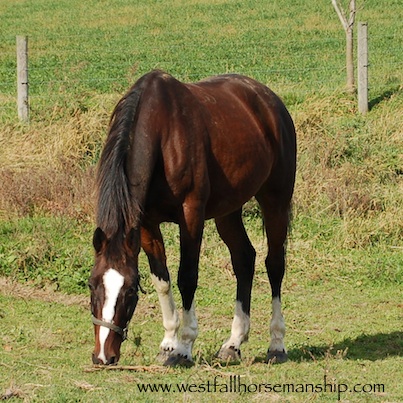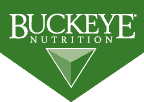 “I have always wondered how long after feeding should you wait before working with ( round pen training, riding, and so one) and how long should you wait to feed a horse after being worked? I was always told 2 hours after eating by someone dear to me. But I have had a few people tell me it doesn’t matter. And the vet never gave me a straight answer. So what is your input on this?” -Question from Facebook
“I have always wondered how long after feeding should you wait before working with ( round pen training, riding, and so one) and how long should you wait to feed a horse after being worked? I was always told 2 hours after eating by someone dear to me. But I have had a few people tell me it doesn’t matter. And the vet never gave me a straight answer. So what is your input on this?” -Question from Facebook
This question may be tough for people to make generalizations about because there are so many different ways to feed and so many definitions of ‘work’. I will give you my short and simple version and then, below, you can see the ‘high tech’ answer that I got back from Buckeye Nutrition. I do love that I can call an equine nutritionist anytime I want, lol.
Most of our horses here are pretty easy keepers. We feed as close to all you can eat, free choice hay, as possible. That means that our young growing ones have hay in front of them all the time. Popcorn however tends to get chubby so he is fed twice a day hay. He runs out for a few hours in-between, and he usually has a first cutting grass. The young ones usually have a second cutting with some alfalfa mixed in.
I feed most of them Buckeye Gro N Win, which is a high quality pellet that is concentrated so you can feed  less weight. I just went to Buckeyes website and the feed company that I previously used. Using the calculators on both sites; same horse weight, same work load;
less weight. I just went to Buckeyes website and the feed company that I previously used. Using the calculators on both sites; same horse weight, same work load;
BUCKEYE-Feeding Gro N Win……..RECOMMENDED 2 lbs per day
The OTHER company………………..RECOMMENDED 7.75 lbs per day
Many of my horses would blow up like balloons (Popcorn) on nearly eight pounds of grain per day. So back in-the-day I just underfed the ‘other’ brand….unknowingly underfeeding the nutrients because I was trying to restrict the calories.
Feeding much less weight I am much more comfortable working the horses sooner. I personally wait and hour or two if I’m going to do much hard work. If I am headed out on a trail ride I am OK heading out pretty soon because its not going to be very hard. And my horses aren’t eating a lot of weigh. The more pounds they eat of grain the more time I tend to give them. And always remember nice clean WATER.
Now for the ‘high tech’ answer! Provided by Buckeye Nutrition:
The timing of meals prior to exercise and competition really depends on what the horse will be eating and how it will be exercised. Research has shown that a grain meal fed two hours before exercise (e.g. the endurance and speed phase of a 3-day event), either with our without hay, decreased free fatty acid availability and plasma glucose concentrations (Pagan and Harris, 1999). Additionally feeding grain meals three hours prior to exercise also decreased free fatty acid concentrations and plasma glucose concentrations, both of which serve as fuel for the horse during exercise (Lawrence, 1993). Limiting the two main fuel sources for energy can be detrimental to performance, especially higher intensity performance such as 3-day eventing and racing. Feeding hay alone did not decrease the availability of free fatty acid and glucose; therefore performance will not be limited by the decrease in fuel sources as typically seen when feeding a grain meal. Feeding hay may produce a decrease in plasma volume and elevated body weights, as seen with grain meals. However, feeding hay in small amounts my reduce the negative effects typically seen in stalled horses where hay has been withheld (ulcers, vices).
A definitive cut-off time has not been established for meals prior to exercise or competition, however most research suggests that feeding endurance horses a grain meal 3 hours prior to a ride and 2-3 hours prior to exercise for most other performance horses, will help reduce the negative effects seen when feeding too close to a bout of exercise. Most of the feeding recommendations are applicable for intense exercise of longer duration (racing, polo, endurance rides, fox hunting). Drawbacks to a grain meal prior to exercise, such as decreased fuel availability or increased heart rates, should not adversely affect horses in low intensity or short duration exercise (pleasure, equitation or even short timed events such as barrel racing).
Feeding after exercise can be just as important as feeding prior to the event. If the horse is exercising at high intensities, or for long durations, it is crucial that it receives forage and grain (if needed) after exercise. Concentrates should be fed two hours after intense exercise. Feeding forage and grain after exercise is essential for restoring glycogen (stored glucose) pools in the liver and muscle. Remember glycogen is the primary fuel for exercise…like gasoline for our cars. Once the gasoline runs out, the car stalls. Once glycogen is depleted during exercise, the horse fatigues and can no longer continue. It is imperative that performance horses replenish their depleted glycogen stores so they have enough “gasoline” to perform the following day. Don’t forget that it takes several days of rest, relaxation and adequate carbohydrates to completely refill the “gas tank.”
9 Comments
Leave a Comment

FREE PDF DOWNLOAD
WHY IS MY HORSE...?
100% Private - 0% Spam
No one taught you the skills you need to work through these things.
Riders often encounter self-doubt, fear, anxiety, frustration, and other challenging emotions at the barn. The emotions coursing through your body can add clarity, or can make your cues indistinguishable for your horse.
Learning these skills and begin communicating clearly with your horse.
Click here to learn more.

Thanks a bunch 🙂 I’ve been reading up on the Safe & Easy Pelleted and this feed seems to be the best fit for my horse. Again…thanks.
Heidi D
Since we’re talking about feed I’m looking for the closest dealer to Maine for Buckeye Nutrition. I’m feeding Blue Seal Strider right now and the amount of grain reccomended for my horse is way to much for her. She is a very easy keeper and lightly worked and I have tried other grains but found that she gets these bursts of energy where she’s. almost like a bomb eaiting to explode
I know Buckeye was looking at distribution in New England….give them a call or shoot them and email here is the contact page
Thank you for posting this! As a green reiner, we often have the first runs of the day, requiring early warmups. I have been unsure how to handle the morning feedings at the shows! this is great information!
Thanks for sharing! Do you still have your three minis?
My son sold his (was always the plan) but I still have mine! At least I think they are minis….they look like walking fur-balls right now! More hair than any horse will get all winter…and it isn’t even November yet!
My mini’s are also really fluffy. I am teaching my one mini how to bow, she is learning quickly. Are you still carting your minis?
I’m at a barn now where the grass hay is low quality #2 cut, so not sure how to add to their diet to get more nutrients in their until barn owner gets better hay in…any ideas? don’t want to add alfalfa and do give them some orchard to overcome this problem.
Very good information! My horses are turned out 24-7. They do have a shelter they can go to. They get just a tiny bit of feed twice daily. I will only give them hay in inclement weather. They seem to be doing great.